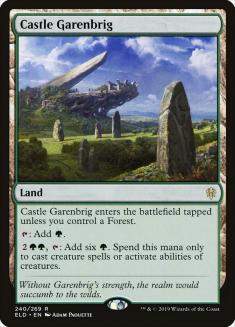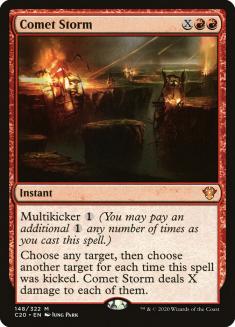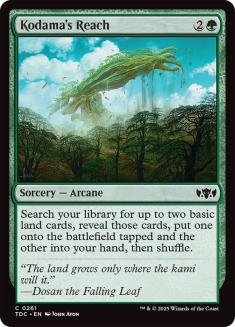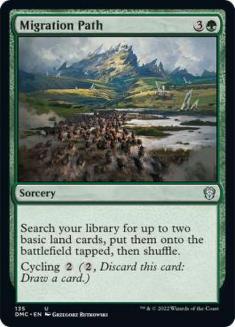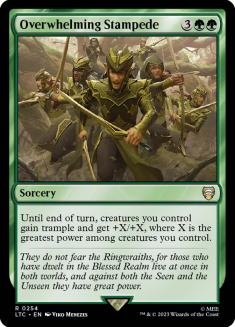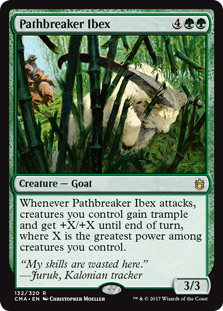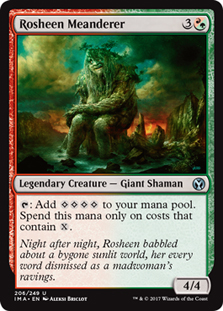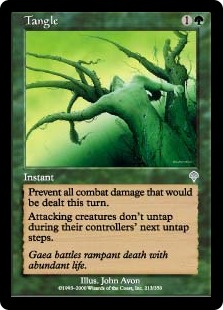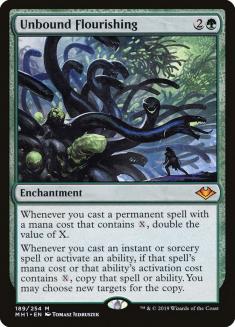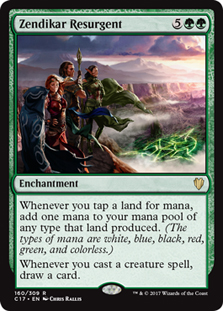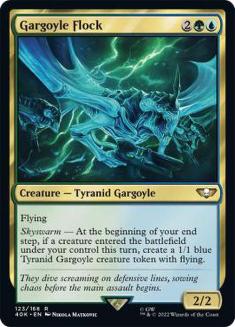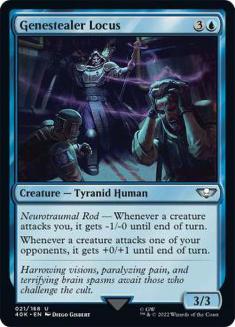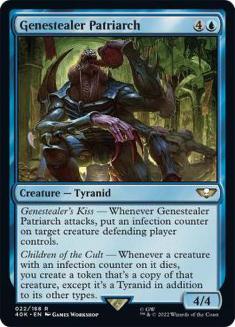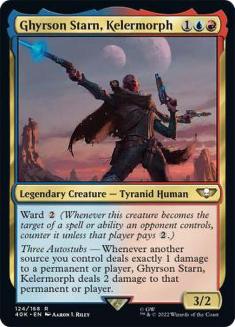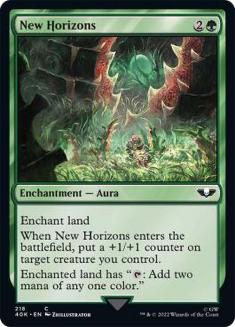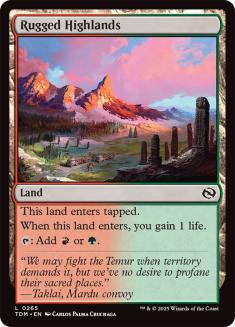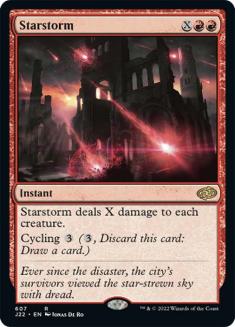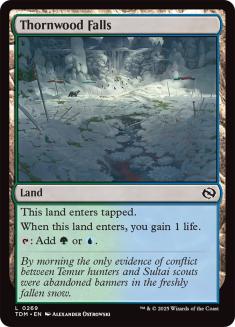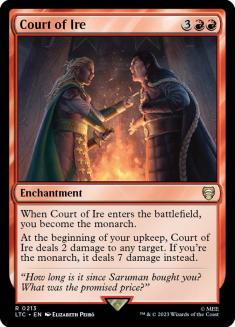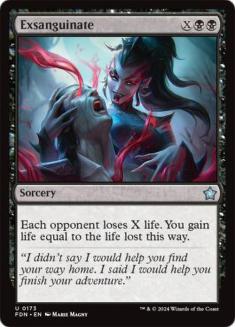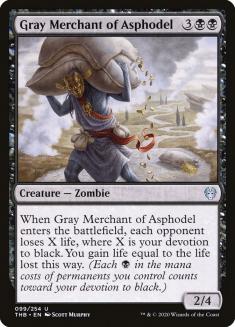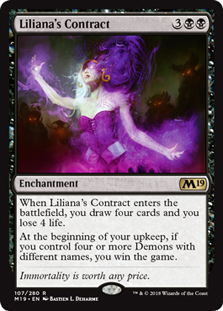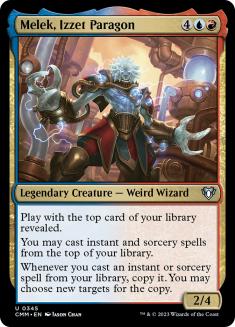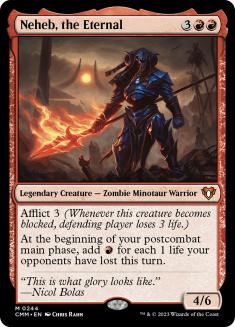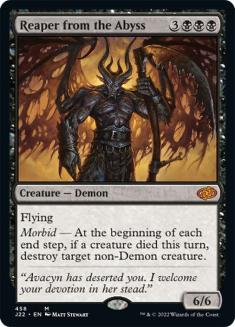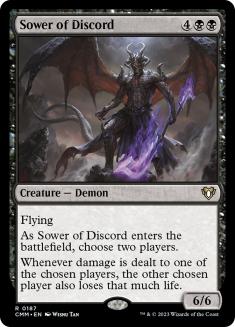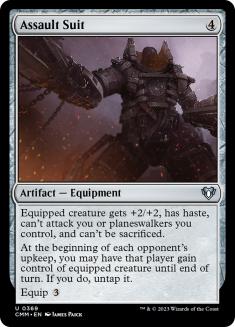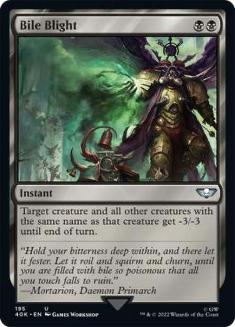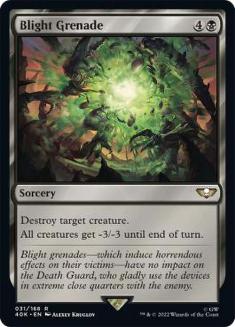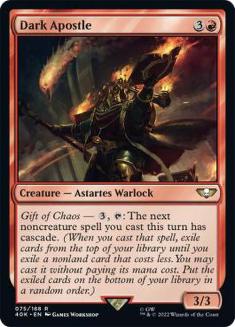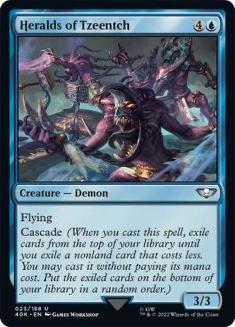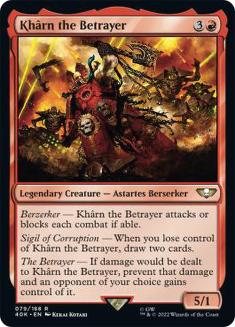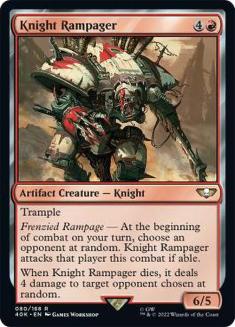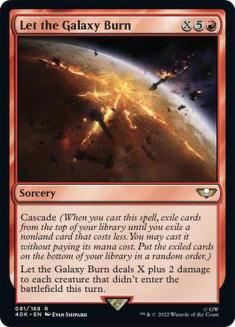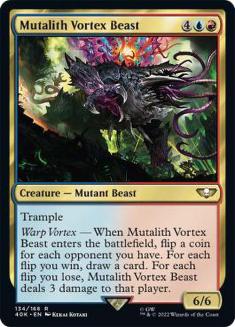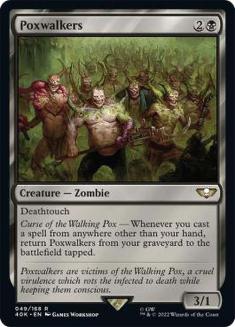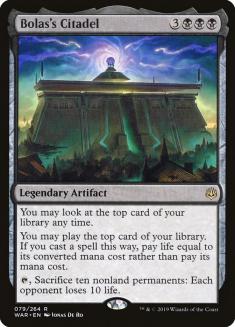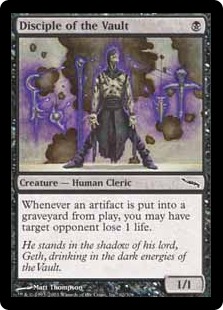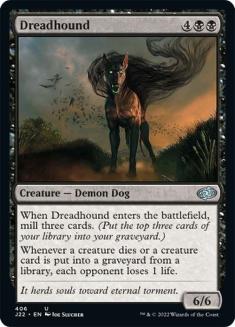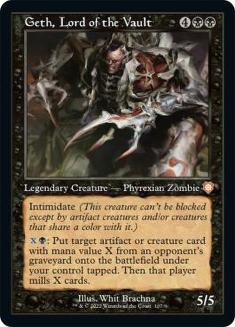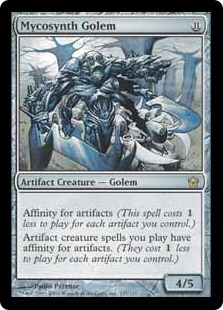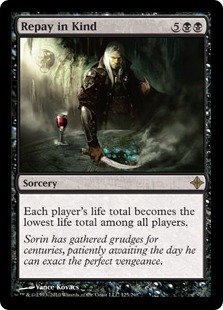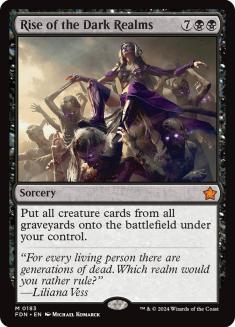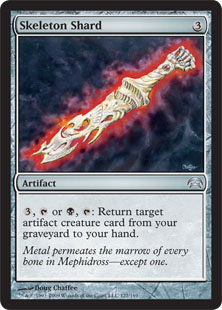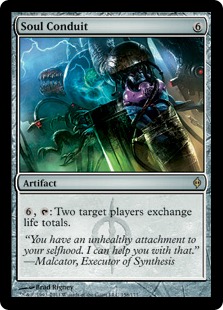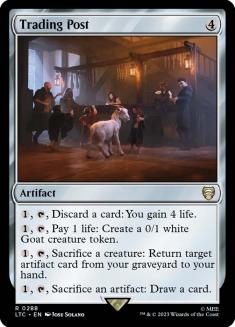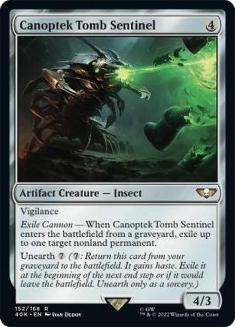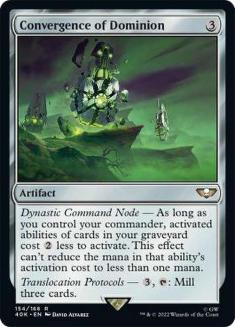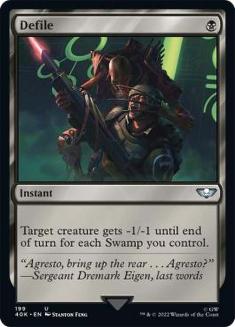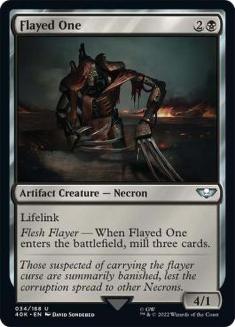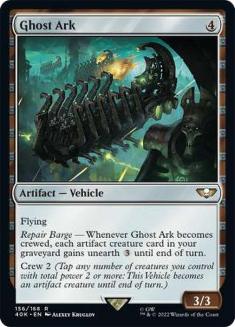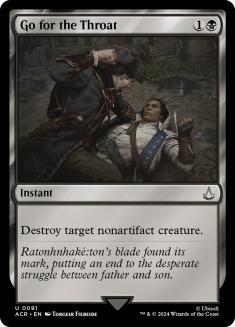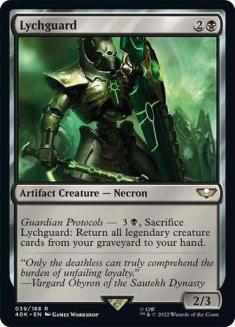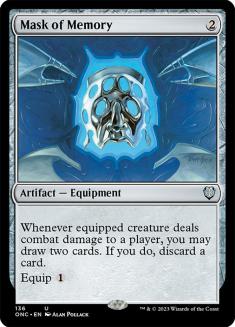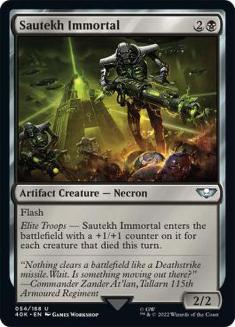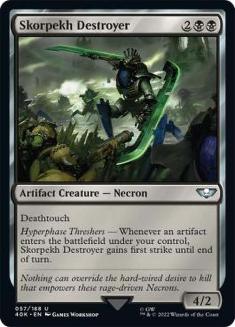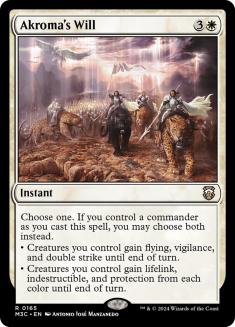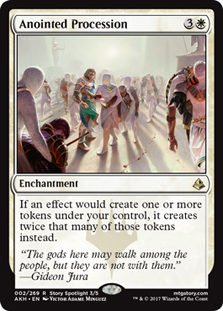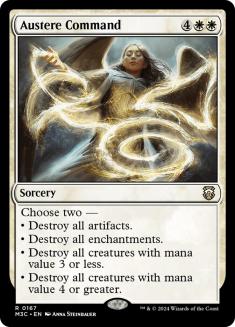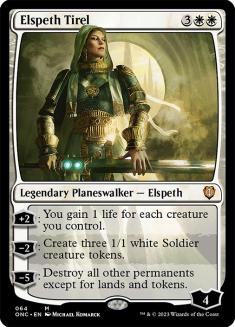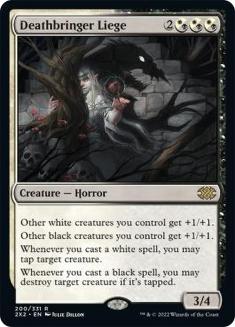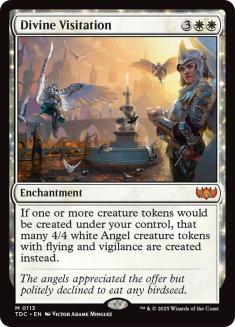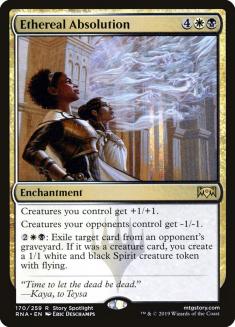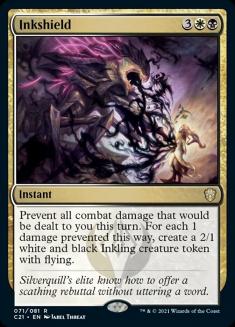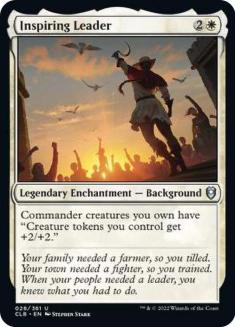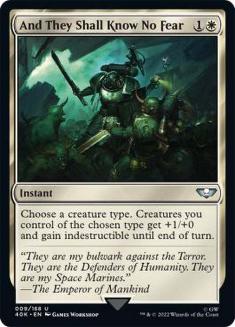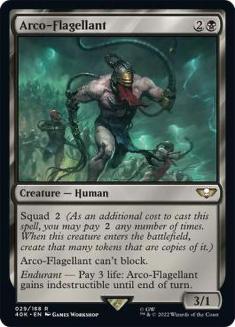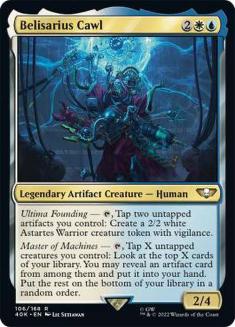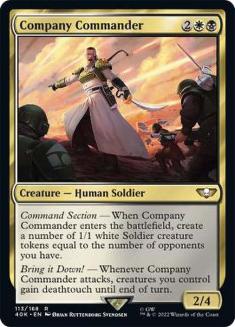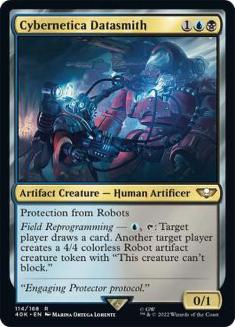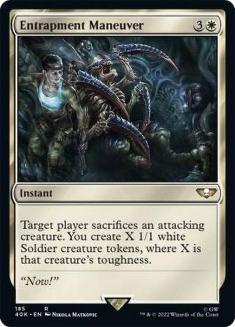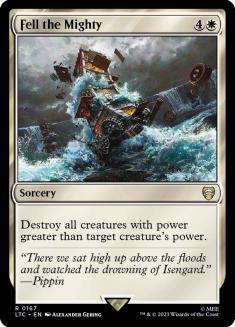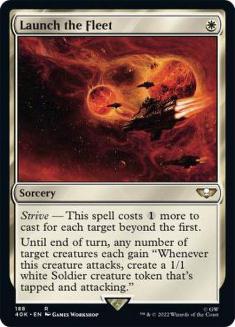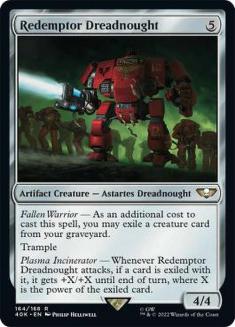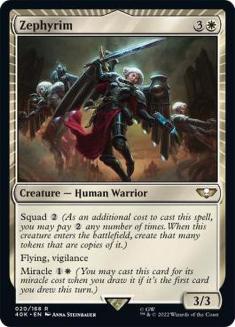The offerings from Warhammer 40,000 might be the best preconstructed Commander decks ever. They play extremely well right out of the box, operate nicely in the biodome with each other, and can hold their own in an open field. They’re tight, have reasonable mana bases, and important to our purposes here today, serve as most capable foundations to build on.
One of the sub-formats (variants?) that the other Commander Rules Committee (RC) members and I have discussed is the Ten-Card Upgraded Precon. We did it to great success with the deck from Adventures in the Forgotten Realms. I still have my Sefris Dungeons deck together (I didn’t realize until I went over to Archidekt that its full name is actually Sefris Dungeons Upgraded Precon) and intend to keep it, providing me with viable lower-powered deck should the need arise. Having a full complement of upgraded precons laying around means that I can just grab and go with three friends who might not be fully-invested Commander players or folks like me who sometimes want a slightly more down-tempo match and know that the power levels will be balanced enough to have good games. If we eventually make the move to having official variants, I fully expect this to be one of them.
The premise of the Ten-Card Upgraded Precon is simple. You can take out any ten cards you like and replace them with otherwise-legal cards which aren’t already in the deck. I might make a rule that you still have to stick with one of the deck’s legendary creatures as the commander, although who’s to say you wouldn’t be able to make something really compelling by slotting in someone new? Change the commander or not, you can seriously upgrade the mana base, make a significant strategic change, or tinker around anywhere in the middle ground. I’m going to run through the exercise of making the change to all four of the decks—and I’m not just going to cannibalize the cards I want to play in other decks (that’s what buying singles is for!). Depending on the direction I take the deck, the most interesting cards will likely stay put. You can check out all the original deck lists on the Wizards of the Coast site.
With only ten upgrade slots, we’ll have to be careful with what comes out. Even though the mana bases in these decks are significantly better than Commander preconstructed decks from the early days, we could still spend a lion’s share of our slots in just fixing lands. For the most part I’ll avoid the call of that particular siren, although I think we can come down a land in each of the decks and replace it with a business card. Any way you look at it, cards are going to have to come out. It’s not that they’re bad, it’s that we want to do something else.
I’ll also avoid trying to make the decks demonstrably faster. Ten cards could just go into some kind of speed package, but I’d rather focus on making more interesting things happening than making what already happens get there sooner. We might shave some time by reducing (although not eliminating) the number of enters-the-battlefield tapped lands in the deck.
The other thing I’ll avoid is an easy-to-assemble infinite or game-ending combo. I’d like the decks to be able to play together, not just race to see who can go off first. I won’t shy away from cards that are potentially bad news for one of the other decks, although it doesn’t seem right to specifically metagame against them.
Tyranid Swarm
We’ll start with the tough one, since The Swarmlord of Hydras is the first deck I built out of a Warhammer 40,000 commander. The first thing I’m going to do here is switch up the commander and let Magus Lucea Kane run the show. Copying all those creatures with ravenous will be sweet indeed. This won’t count as one of the ten upgrades since Swarmlord will stay in the ninety-nine. Its second ability is most relevant, at least providing replacement cards when our creatures get nuked.
The focus for the Tyranid Swarm deck will be to make the go-wide strategy even more savage. We’re in colors that can make additional combats steps if we like, although that’s not the way I’d want go here. We certainly have the capability to make Overrun happen, but we still have to be careful about filling up too many slots.
In:
Out:
We’ve gone for a ramp change, getting lands out of the deck with Migration Path instead of providing additional mana when tapping the lands with the enchantment New Horizons. Overgrowth definitely stays, though, since it makes two extra mana, not just one. It’s not that I worry that New Horizons would be eating enchantment removal or worse yet, get caught up in a sweeper of some kind. I just like thinning the deck by getting that extra land out of it. Migration Path cycles, so it’s not dead in the late game. We’ll then put in Kodama’s Reach for that extra land.
For even more mana explosion, we’ll go with Castle Garenbrig and X-spell daddy Rosheen Meanderer. It’s too much to suggest an upgrade like Gaea’s Cradle, although I suppose if you got ’em, smoke ’em. We’ll take the idea into the stratosphere with Unbound Flourishing, which will turn ravenous into galactically hungry. What’s neat about Unbound Flourishing is that is changes the value of X, which manes we’d only need an X of three (or greater) to trigger the ravenous card draw ability. Since we’ll be casting lots of creatures and would love even more mana, we can top out with Zendikar Resurgent. Suddenly, we might not need to go particularly wide, instead making just a giant Broodlord or Tervigon. Those changes then suggest a finisher, Comet Storm, straight up for Starstorm. Copying Comet Storm via Magus Lucea Kane will end up with some crispy opponents.
As far as the Overrun path, we’ll dedicate two slots to it. One is Overwhelming Stampede, which is guaranteed to get some really good hits. The other is everyone’s favorite goat, Pathbreaker Ibex, which functionally does the same thing (assuming you don’t mind one of the deck’s creatures not being a Tyranid). From my understanding of the Tyranids, Triumph of the Hordes would be thematically appropriate—but it’s such a polarizing card, I’d only want to play it with my innermost circles of friends. I’d be hesitant to foist it on folks I don’t know.
Finally, you know I constantly remind you to (stay in school, eat your vegetables, and) play your Fogs. The last slot then goes to our Fog of choice. I’ll lean toward the idea that there will be lots of combats happening in the Warhammer 40,000 biodome. When someone battles you and you want to prepare them for the crack back, accept no substitute for Tangle. Spore Cloud is a hidden game answer here for one more mana. I suppose that you can use Cryptic Command as a Fog and have it do other things, but the commitment to blue in this deck is not nearly high enough to play it.
The Ruinous Powers
With Tyranid Swarm being a new creature type tribal deck, The Ruinous Powers stands as an existing tribal deck painted with a Warhammer 40,000 brush. The mechanical feature here is a return to cascade—and everyone knows that free spells are the most delicious spells. The face commander, Abaddon the Despoiler, gives all your spells on your turn cascade X, with X being the total amount of life our opponents have lost this turn. It’s obvious that with a little attacking, we’ll get X to a point where everything in the deck cascades. While there’s a real draw to use Be’lakor, the Dark Master as the command because of its ability to deal damage from every Demon entering the battlefield under our control, Abaddon gets us free stuff. It’s also one cheaper to cast, which is significant because this is a Grixis deck—large amounts of mana are tricky to come by.
This is a deck that has some creature support, but really likes casting spells. There are seventeen instants and sorceries in the original design. While some are coming out, we’ll be putting some right back in, too. As with the previous deck, there are cards leaving the deck that which fine in their own right. They simply don’t further the kind of tight plan we’ll need to stand our ground with those other decks. I won’t call out any of them specifically since there aren’t strict upgrades to any card and none of the cards we’re taking out are leaving because they’re not good.
We’ll lean further into main two areas: Demon tribal and our opponents losing life on our turn in ways that don’t necessarily mean combat (although that’s fine, too). The land count is right at thirty-eight and we don’t want to spend any upgrade slots on the lands, so we’re going to grin and bear the slightly awkward mana base.
In
Out
The big upgrade creature-wise comes from Archfiend of Depravity, Reaper from the Abyss, and Sower of Discord. Archfiend of Depravity will help against the decks that will try to swarm us by limiting them to two creatures on the battlefield. Similarly, Reaper from the Abyss will keep other players’ creature counts lower, although it won’t trigger in the end step after Archfiend of Depravity has done its thing. Sower of Discord is a very Commander card and will get the two players’ life totals dwindling in short order. Liliana’s Contract is the other Demon card. It’ll draw four cards and occasionally squeak out some wins for us, especially if we’ve been making Demon tokens with Great Unclean One.
I’ll confess joy that a card that I designed fits wonderfully into this deck. Keen Duelist will have a targeted opponent lose life (most of the time, so long as we don’t reveal a land) during our upkeep. We have some hefty mana values in the deck for doming the other player with, which then means we’ll be flexible on when we want to cast other spells and get that sweet cascade. Court of Ire will add either two or seven to the total, the latter allowing everything in the deck to trigger cascade. The Meathook Massacre works around the awkwardness of cascading into it by still having some value once it’s on the battlefield, draining each opponent for each creature we lose. The big, potential finisher that fits into this category is Gray Merchant of Asphodel. Neheb, the Eternal piggybacks on the life loss by providing mana to cast more spells.
Melek, Izzet Paragon is there to take advantage of The Lost and the Damned and Keeper of Secrets, which trigger on casting spells from zones other than our hand. It’s effective card draw which keeps us churning through the deck. If the deck had more of a commitment to blue, Future Sight would have been a better choice.
Necron Dynasties
Mono black artifacts is a deck choice I don’t think we’ve really had before, so the Necrons have broken some new ground. It keeps the upgrade path pretty narrow. I’m not sure there’s a transformative direction, only one in which we do even more of what the deck does already. The Vehicle path isn’t all that exciting, so it’s what seems most viable for removing as a subtheme. I’m also not sure the unearth road is one that’s all that great to ride down. The problem is that when an unearthed creature leaves the battlefield, it gets exiled. None of them are so powerful as to be finishers, so we need them around for longer.
What could be transformative is a change of commander. There are several legendary creature options beyond the two the deck presents. Anrakyr the Traveller offers an excellent attack trigger, allowing us to pay life to cast an artifact spell from hand or graveyard by paying life. We’re going to use the life payment idea as the deck’s directional shift. It also keeps a commander damage kill opportunity alive by making Imotekh the Stormlord one of the ninety-nine and using its beginning of combat trigger to buff Anrakyr.
In
Out
Cards in the life payment line are Bolas’s Citadel, Repay in Kind, and Soul Conduit. Like Anrakyr, Bolas’s Citadel allows life payment to cast spells, these from the top of the library. Unlike Anrakyr, we can keep casting things until we hit that dreaded land. With our life total lower, Repay in Kind and Soul Conduit become viable. Repay in Kind sets everyone to a low life total; the deck’s various draining effects then take over. Soul Conduit exchanges life totals between two players. Note that we don’t have to be one of them, so there is lots of tomfoolery possible there. I avoided adding Wound Reflection with this line, since it’s a high salt score card and just kind of feels cheap (as it’s being dreadfully efficient at killing people).
Mycosynth Golem offers a discount on all the artifact creature cards in the deck. Unlike traditional artifact decks, there are some colored pips on the creatures in this one, so we won’t be casting as much for free—but we can deal with that relatively easy via a card like Illuminor Szeras. Illuminor Szeras is my favorite card in the deck because not only does it produce a fairly large amount of mana, it puts cards in the graveyard to be reanimated. It’s top notch engine fuel.
Artifacts and creatures are going to be put into the graveyard with this deck, so Disciple of the Vault and Dreadhound are methods of getting through some non-combat damage. Dreadhound carries the added benefit of making all of our opponents’ mills into potential life loss. That milling and creatures generally dying led to Geth, Lord of the Vault, whose mill function often gets overlooked as the secondary effect to reanimating a creature. If there’s a great deal of milling going on—and once again, creatures dying—then Rise of the Dark Realms will be a great finisher, as we simply get it all.
Skeleton Shard and Trading Post are simply value cards for the deck. Getting back any artifact creature card for just one black mana with Skeleton Shard means that we can keep our engines running at a low cost. While we won’t be making too many Goat tokens with Trading Post, we’ll use all three of the other abilities. We can discard a card to then be reanimated, gaining four life in the process. We can sacrifice a creature that’s about to die anyway to get back a precious artifact. The same is true for any artifact, only we can draw a card.
Forces of the Imperium
The tokens deck is a hard one to upgrade. Once again, we’ll find ourselves being a more extreme version of what the deck wants to do, as it’s already pretty good at doing it. We’ll lean into using the tokens in various ways, to include the relatively straightforward idea of swarming our opponents. We’ll stick with the face commander of the Imperius, Inquisitor Greyfax, who provides an anthem effect while giving our creatures vigilance as well as a method of tapping down a problematic creature.
In
Out
Anointed Procession and Divine Visitation are about changing the nature of the tokens we create. Anointed Procession simply doubles the number of tokens created. Divine Visitation turns them from the 1/1s we most commonly make into 4/4 Angels with flying and vigilance instead.
Springboarding off of Inquisitor Greyfax, Ethereal Absolution and Deathbringer Liege are anthems that also do something else. Ethereal Absolution makes all our opponents’ creatures smaller, wiping out those with one toughness. In addition, it gives us some graveyard control, albeit expensively. Deathbringer Liege is a longtime favorite. It buffs most of our team while having two triggered abilities that we can combine to kill any creature whenever we cast a spell that’s both black and white. Inspiring Leader also goes into the anthem category, giving all of our creature tokens +2/+2 so long as we control Inquisitor Greyfax. There’s an argument for this slot to be used on Eldrazi Monument instead, making our team extremely hard to kill.
Elspeth Tirel, Austere Command, and Teysa, Orzhov Scion are all creature control cards. After using her -5 ability, Elspeth Tirel should leave us in a pretty commanding board position. Austere Command gives us the flexibility to get rid of which classes of permanents we need to. Teysa, Orzhov Scion provides the ability to exile creatures, which is significant in an environment that likes to recycle creatures. It also makes us yearn to have another upgrade slot in which to put Teysa Karlov.
Akroma’s Will is an extremely flexible card that can be used offensively or defensively. Granting all of our creatures flying, vigilance, double strike, lifelink, indestructible, and protection from all colors will lead to the kind of alpha strike that will kill at least one player and leave us in a strong position in regards to any players left. On the defensive side, most of those abilities make a great combat trick that can really blow out an attacker. Alternately, giving the team indestructible will save us from the board sweepers that don’t involve exile.
Finally, you didn’t think that I’d be able to resist putting Inkshield into a deck that can support it, right?
The upgrade paths available for each of the Warhammer 40,000 decks are many. What has come before here is simply one of them. Ten cards is enough to transform much of the way a deck functions, or as I’ve done here, simply turbo-charge what it already does. Any way you look at it, planning for and executing the upgrades makes for enjoyable and rewarding work.
Always remember we have a channel on the Commander RC Discord server dedicated to discussing my articles. I’d love to hear about features that you’d like to see, material you want more coverage on, or even things that you think just aren’t working. I’m all ears. Join nearly 8,000 friends for discussion of not just this piece, but on a wide variety of topics—both Commander-related and not. Hope to see you there!
Visit my Decklist Database to see my Signature Decks, the Chromatic Project, and more!


